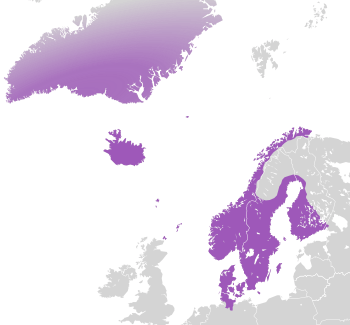Kalmar Union facts for kids
Quick facts for kids
|
|||||||||||||||
|---|---|---|---|---|---|---|---|---|---|---|---|---|---|---|---|
| 1397–1523 | |||||||||||||||
 |
|||||||||||||||
| Status | Personal union | ||||||||||||||
| Capital | Copenhagen (from 1443) | ||||||||||||||
| Common languages | Official use: Middle Danish, Old Swedish, Renaissance Latin Also spoken: Middle Low German, Finnish, Karelian, Middle Norwegian, Middle Icelandic, Norn, Sami languages, Greenlandic Greenlandic Norse |
||||||||||||||
| Religion | Roman Catholicism | ||||||||||||||
| Government | Personal union | ||||||||||||||
| Regent | |||||||||||||||
|
• 1387–1412a
|
Margaret I (first) | ||||||||||||||
|
• 1524–33
|
Frederick I (last) | ||||||||||||||
| Legislature | Riksråd and Herredag (one in each kingdom) | ||||||||||||||
| Historical era | Late Middle Ages | ||||||||||||||
|
• Established
|
17 June 1397 | ||||||||||||||
|
• Engelbrekt rebellion
|
1434–36 | ||||||||||||||
|
• Stockholm Bloodbath
|
November 1520 | ||||||||||||||
|
• Gustav Vasa elected King of Sweden
|
6 June 1523 | ||||||||||||||
|
• the Danish Rigsråd annexes Norway
|
1536 | ||||||||||||||
|
• Disestablished
|
1523 | ||||||||||||||
|
• Treaty of Kiel
|
14 January 1814 | ||||||||||||||
| Currency | Mark, Örtug, Öre, Swedish penning | ||||||||||||||
|
|||||||||||||||
| Today part of | |||||||||||||||
|
|||||||||||||||
The Kalmar Union was a special agreement that brought together the kingdoms of Denmark, Norway, and Sweden. It also included many other areas that belonged to these countries. For example, Norway included places like Iceland, Greenland, the Faroe Islands, Shetland, and Orkney. Parts of Finland were also part of Sweden at that time.
This union began in 1397 at a meeting in the town of Kalmar in Sweden. It lasted for over 120 years. The union finally ended on 6 June 1523 when Sweden decided to leave. This happened when Gustav I became the King of Sweden.
Contents
What Was the Kalmar Union?
The Kalmar Union was a "personal union." This means that the three kingdoms – Denmark, Norway, and Sweden – shared the same ruler, but they kept their own laws and governments. It was like having one boss for three different companies, where each company still had its own rules and ways of doing things.
Why Was It Formed?
The main goal of the union was to create a strong power in Scandinavia. This would help them stand against the growing influence of Germany, especially the Hanseatic League. The Hanseatic League was a powerful group of trading cities that controlled much of the trade in the Baltic Sea.
How Did the Union Start?
The idea for the union came from a very powerful woman named Queen Margaret I. She was the Queen of Denmark and Norway. In 1389, she also became the ruler of Sweden.
The Meeting in Kalmar
On June 17, 1397, a big meeting was held in Kalmar, Sweden. Representatives from all three kingdoms came together. They signed an agreement that officially created the Kalmar Union. Margaret's great-nephew, Eric of Pomerania, was crowned king of all three kingdoms. However, Margaret continued to be the real ruler until her death in 1412.
Who Ruled the Union?
The union was ruled by a series of kings and queens. They were supposed to rule all three kingdoms fairly. However, the rulers often favored Denmark, which caused problems.
Challenges of Ruling
It was hard to keep all three kingdoms happy. Each kingdom had its own powerful noble families and councils (called Riksråd or Herredag). These groups wanted to protect their own interests. Sweden, in particular, often felt that Denmark had too much power.
Why Did the Kalmar Union End?
The union faced many challenges and conflicts over the years. The main reason it ended was the constant disagreements and wars, especially between Denmark and Sweden.
Swedish Rebellions
Sweden often rebelled against the union's rulers. They wanted more independence. One important rebellion was the Engelbrekt rebellion (1434–1436). These rebellions showed that the union was not as strong as it seemed.
The Stockholm Bloodbath
A very famous and terrible event that led to the end of the union was the Stockholm Bloodbath. This happened in November 1520. The Danish King, Christian II, had many Swedish nobles and important people executed in Stockholm. This event made the Swedes even more determined to break away from the union.
Gustav Vasa and Swedish Independence
After the Stockholm Bloodbath, a Swedish nobleman named Gustav Vasa led a successful rebellion. On June 6, 1523, Gustav Vasa was elected King of Sweden. This marked the official end of Sweden's time in the Kalmar Union.
After the Union
Even after Sweden left, Denmark and Norway remained in a union. This union, known as Denmark–Norway, lasted until 1814. The Kalmar Union was an important part of Scandinavian history. It shaped the future of these countries for centuries.
See also



